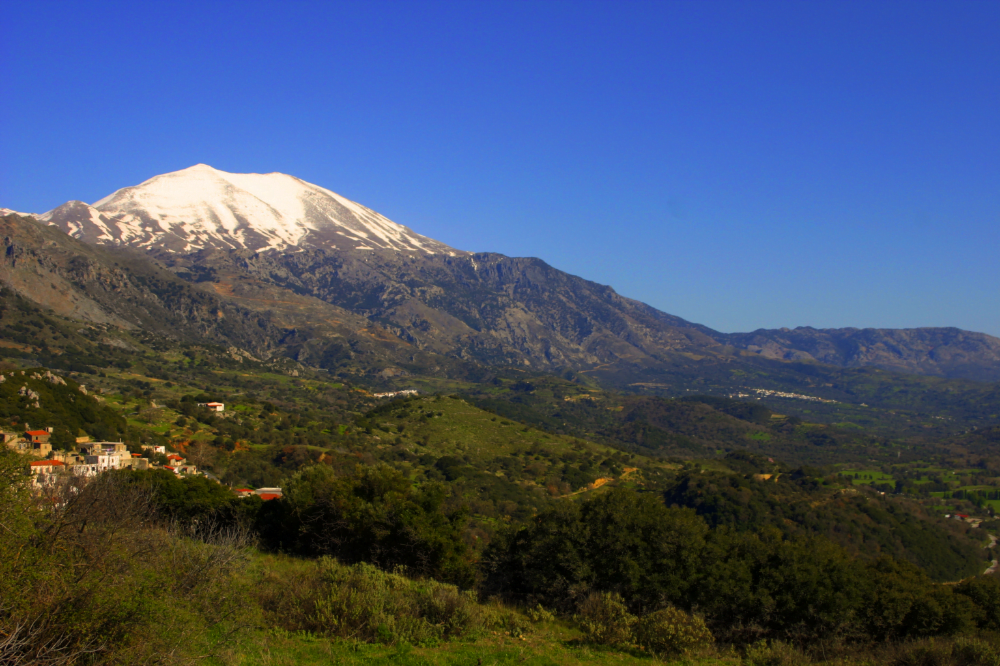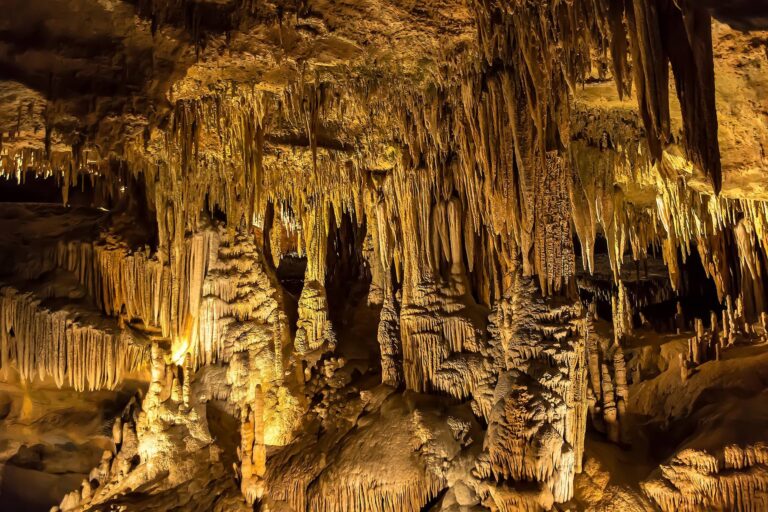The Amari Valley -The Hidden Diamond
The Hidden Gem of Crete
Suppose your journey takes you from Rethymno through Spili to Agia Galini or the Messara Plain, or from Iraklion to Festos and Matala. In that case, you might inadvertently bypass one of Crete’s most enchanting regions – the Amari Valley. This serene and picturesque valley, nestled between the mountains, is a hidden treasure waiting to be discovered.

The Amari Valley, perched five to six hundred meters above sea level (approximately 1,800 feet), boasts an idyllic climate. The valley is a verdant oasis, home to olive trees and some of the finest cherry trees on the island. In the spring, these cherry trees burst into a spectacular display of blossoms, transforming the valley into a sea of white.
A month later, the branches are laden with succulent, almost black-red cherries that delight the palate. Local artisans preserve these cherries in syrup to create cherry glyko, a sweet delicacy that can be enjoyed all year round. Paired with local yoghurt, a spoonful of this cherry glyko is a heavenly treat.

As you wander through the neatly arranged fields of the Amari, you’ll encounter hundreds of apple trees. Some are trained in cordons, while others stand freely, their branches within easy reach. The taste of a freshly picked, slightly sweet apple from these trees is divine. The valley is a veritable Garden of Eden, with fields of corn, cabbages, lettuces, and many other crops.
The Amari Valley is cradled by the majestic Psiloritis, or Mount Ida, to the east, and the Kedros mountains to the west. These mountain ranges and their foothills enclose the valley, creating a secluded haven. The valley also boasts its own mountain, Mount Samitos, standing proudly in its centre.
The valley is crisscrossed by numerous rivers and streams, which irrigate the fields. These waterways converge and flow into large caves, uniquely displaying nature’s ingenuity. From there, they travel underground through vast, ancient caverns, eventually resurfacing outside the Amari and making their way to the sea.
The Amari Valley is a riot of colour in the spring, with wildflowers blooming in every corner. Fields of deep dark blue, red, and pink anemones sway in the breeze alongside wild gladioli, narcissi, and lupins. The valley is also home to the exquisite wild Cretan orchids, their intricate beauty unmatched anywhere else in the world. Houses are adorned with pots of geraniums and other flowers, their vibrant colours cascading down the walls from terraces.
The floral landscape changes as spring gives way to summer, but the valley remains just as beautiful. Imagine strolling through the fields, plucking grapes from a nearby vine, the silence only broken by the chirping of birds or the distant tolling of bells announcing a wedding or baptism. The grapes are sweet and firm, the olives are maturing, and the richness of the land is palpable. The Amari Valley, with its natural beauty and serene ambience, is indeed a slice of paradise on the island of Crete.
The Enchanting Amari Villages
The Amari villages, mostly petite and nestled on the hill slopes, are a sight to behold. A winding road meanders through these villages, providing a complete circuit around the valley. The Amari region remains largely untouched by the usual tourist bustle, making it a hidden gem on the island. As such, signs advertising rooms for rent or tavernas with English menus are few and far between. However, accommodations can be found in the villages of Gerakari and Thronos for those seeking a tranquil retreat.
Thronos, located in the northern part of the Amari, is home to a unique establishment – the Taverna Aravanes. This taverna, which also offers a few rooms for rent, boasts a terrace with a breathtaking view of the Amari Valley. It’s a serene spot to sit, enjoy a meal, and let your imagination wander back to the Minoan era, some five thousand years ago, when the first settlers made this valley their home.

Thronos is steeped in history, believed to be one of the many ancient Cretan cities built by the Dorians or possibly the Myceneans – the exact origins remain shrouded in mystery. As you stroll through the village, you’ll encounter architecture that seems to defy the passage of time. At the village’s heart stands a small, locked Byzantine chapel called the Church of the Panagia. The key to this chapel is held by the taverna owners, who will gladly let you in to witness the astonishing 11th-century frescoes adorning the walls. These frescoes are so invaluable that photography is discouraged. However, you can purchase professionally taken photographs of these stunning artworks for a small donation to the church.
The Church of the Panagia also features a mosaic floor of intricate design, both inside and outside. Interestingly, the floor’s area is more than twice the size of the current church, suggesting the existence of a previous, grander church on the same site. The village’s name, ‘Thronos’, implies that it was once the seat of a high bishop. The original church might have been constructed during the first Byzantine period in Crete and could have been destroyed around 900 AD when the island fell to Islamic Saracen pirates. The current church was likely built a few centuries later, during the second Byzantine period, after Crete was liberated from the invaders.
While Thronos is a highlight, the Amari region is dotted with numerous other villages with unique charm. Time and space may not permit an exhaustive exploration, but a journey along the more minor roads crisscrossing the Amari and the peripheral road is highly recommended. The village of Amari itself is a must-visit, with its Venetian bell tower offering panoramic views of the valley. Scattered across the region are countless ancient churches, each a testament to this enchanting valley’s rich history and cultural heritage.
The Unexplored Corners of Amari
Venturing further into the Amari region, you’ll find many other villages with unique character and charm. Though smaller and less known, these villages are equally rich in history and culture. The roads that traverse the valley are like threads weaving a tapestry of stories from different eras, each contributing to the rich heritage of the region.
One such village is Gerakari, known for its cherry orchards. This village, nestled amidst lush greenery, offers a serene retreat for those seeking solitude. The warm and welcoming locals are always eager to share stories of their village’s history and traditions. Here, you can rent a room and immerse yourself in the slow-paced, tranquil life of the village, away from the hustle and bustle of city life.
Another noteworthy village is Meronas, perched on the hillside with a panoramic view of the valley. The village is home to the Church of the Archangel Michael, a Byzantine-era church with stunning frescoes. With its stone walls and ancient icons, the church stands as a silent witness to the passage of time.
The village of Fourfouras, located at the foot of Mount Psiloritis, is a paradise for nature lovers and hikers. The village is a starting point for several hiking trails leading to the mountain’s peak. Here, you can enjoy the pristine beauty of nature while exploring the rugged Cretan landscape.
The Amari region is also home to the village of Apodoulou, known for its archaeological site dating back to the Minoan era. Excavations here have unearthed artefacts and structures that provide insights into the ancient civilization that once thrived in this region.
The Rebirth of the Kedros Villages
As you meander through the picturesque landscapes, you might be led to believe that the Kedros villages, nestled on the western flank of the Amari valley, are as ancient as the valley itself. However, this is a common misconception. The truth is these villages have a tragic and inspiring history.
On the fateful day of August 22, 1944, during the throes of World War II, the German forces of occupation set ablaze every village and detonated the houses. The inhabitants were mercilessly shot, sparing almost no one. This horrifying act was a reprisal for the abduction of General Kreipe, the German commander kidnapped by partisans and the British Special Operations Executive (SOE). Others suggest that it was to cover up their withdrawal from the island. Who knows?
In his book, “The Cretan Runner”, George Psychoundakis recounts how he observed the fires raging in the Kedros villages for an entire week from a cave high on Mount Ida. His vivid descriptions bring to life the horror and devastation of those days.
Despite the painful past, the villages today are adorned with numerous memorials commemorating this act. The most striking of these is located just outside Ano Meros. It features a grand statue of a woman painstakingly etching the names of the deceased into stone, a poignant reminder of the lives lost.
Interestingly, the Amari valley was called “Lotus Land” during the war, a codename used by the SOE. This name, suggestive of a peaceful and idyllic place, starkly contrasts the harsh realities of the time.

However, the spirit of the Amari people is truly remarkable. Today, there is hardly any bitterness stemming from past atrocities. The inhabitants of the Amari are among the friendliest you will encounter on the island. Engage in a conversation with them, and you will likely find yourself gifted with abundant fruit to take home. This generosity is a testament to the resilience and nobility of these people, who have managed to transform their tragic past into a beacon of hope and friendship.
You can get to the Amari valley by taking the road from Spili up over the mountain to Gerakari—a stunning drive. Or you could drive south from the monastery of Arkadi or north from the junction on the road between Agia Galini to Tymbaki. One thing is sure, you will remember your visit to this perfect place.
Amari Valley Map
Table of Contents
Visits: 1236







